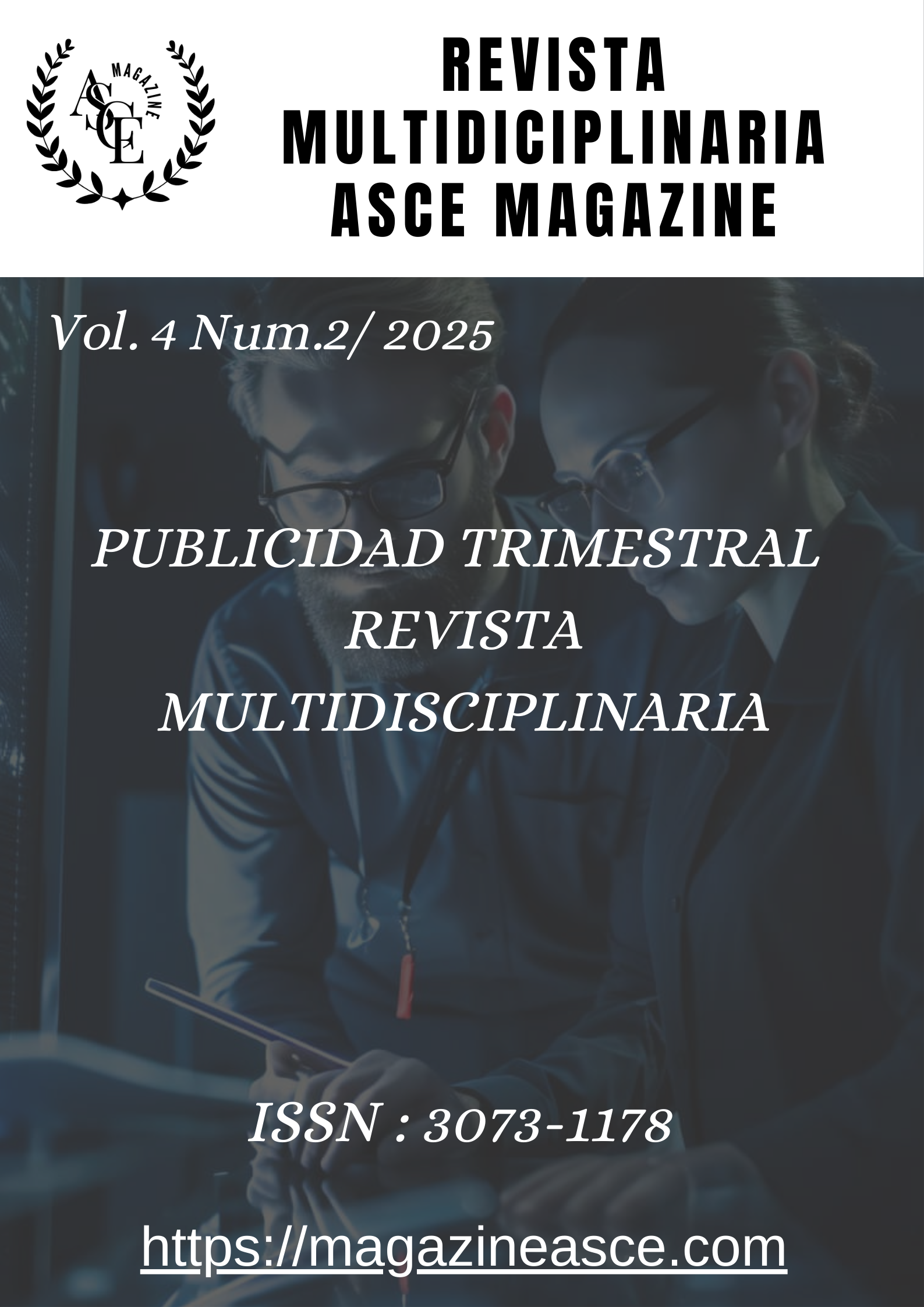Inteligencia Artificial en la gestión de los servicios de salud: Estado actual y perspectivas futuras
DOI:
https://doi.org/10.70577/ASCE/483.502/2025Palabras clave:
Inteligencia Artificial; Administración de Servicios de Salud; Aprendizaje Automático; Eficiencia Organizacional; Control de Costos; Toma de Decisiones.Resumen
Los sistemas de salud enfrentan desafíos crecientes por el aumento en la demanda de atención, el envejecimiento poblacional y la escasez de recursos, por lo que, la inteligencia artificial (IA), surge como una herramienta clave para optimizar la gestión de los servicios de salud, mejorando la eficiencia operativa y la calidad de la atención.
Objetivo: Analizar el uso de la Inteligencia Artificial como herramienta en la gestión de servicios de salud.
Metodología: Se realizó un estudio descriptivo con enfoque cuantitativo, de diseño no experimental y retrospectivo y de revisión bibliográfica. Se realizó la búsqueda de artículos publicados entre 2019 y 2025, en bases de datos como PubMed y Scopus, con términos como "Inteligencia Artificial”, “Gestión de Servicios de Salud" “Administración de Servicios de Salud”, “Aprendizaje Automático”, “Eficiencia Organizacional”, “Control de Costos”, “Toma de Decisiones”; mediante la metodología PICO, se seleccionaron 22 artículos.
Resultados: La inteligencia artificial optimiza recursos con precisiones entre el 88.7-100%, reduce costos hasta un 59% y mejora la eficiencia operativa (AUC 0.82-0.90), destacando su capacidad para anticipar demandas y gestionar personal, aunque requiere capacitación previa para su adopción.
Conclusión: La IA fortalece los sistemas de salud al mejorar la gestión de recursos y procesos, incrementando la calidad de la atención y la sostenibilidad, siempre que se apoye en infraestructura y formación adecuadas.
Descargas
Citas
1. Amin M, Martínez-Heras E, Ontaneda D, Prados Carrasco F. Artificial intelligence and multiple sclerosis. Curr Neurol Neurosci Rep. 2024;24(1):1-10. doi: 10.1007/s11910-024-01354-x DOI: https://doi.org/10.1007/s11910-024-01354-x
2. Topol EJ. High-performance medicine: the convergence of human and artificial intelligence. Nat Med. 2019;25(1):44-56. doi: 10.1038/s41591-018-0300-7 DOI: https://doi.org/10.1038/s41591-018-0300-7
3. Kuprel E, Novoa RA, Ko J, Swetter SM, Blau HM, et al. Dermatologist-level classification of skin cancer with deep neural networks. Nature. (Internet). 2017. (Consultado 27 de marzo 2025);542(7639):115–8. Available in: https://pubmed.ncbi.nlm.nih.gov/28117445/ DOI: https://doi.org/10.1038/nature21056
4. Dabas M, Schwartz D, Beeckman D, Gefen A. Application of artificial intelligence methodologies to chronic wound care and management: a scoping review. Adv Wound Care. 2022;11(4):187-201. doi: 10.1089/wound.2021.0144 DOI: https://doi.org/10.1089/wound.2021.0144
5. Tran KA, Kondrashova O, Bradley A, Williams ED, Pearson JV, Waddell N. Deep learning in cancer diagnosis, prognosis and treatment selection. Genome Med. 2021;13(1):152. doi: 10.1186/s13073-021-00968-x DOI: https://doi.org/10.1186/s13073-021-00968-x
6. Tangri N, Ferguson T, Ravani P, Komenda P, Rigatto C, Dart A, et al. Prediction of kidney failure in chronic kidney disease: a systematic review and meta-analysis. Clin J Am Soc Nephrol. 2022;17(7):1035-44. (URL no disponible en el documento original)
7. Milne-Ives M, de Cock C, Lim E, Shehadeh MH, de Pennington N, Mole G, et al. The effectiveness of artificial intelligence conversational agents in health care: systematic review. J Med Internet Res. 2020;22(10):e20346. doi: 10.2196/20346 DOI: https://doi.org/10.2196/20346
8. Nomura A, Noguchi M, Kometani M, Furukawa K, Yoneda T. Artificial intelligence in current diabetes management and prediction. Curr Diabetes Rep. 2021;21(12):58. doi: 10.1007/s11892-021-01423-2 DOI: https://doi.org/10.1007/s11892-021-01423-2
9. Tello M, Reich ES, Puckey J, Maff R, Garcia-Arce A, Bhattacharya BS, et al. Machine learning based forecast for the prediction of inpatient bed demand. BMC Med Inform Decis Mak. 2022;22:1-14. doi: 10.1186/s12911-022-01787-9 DOI: https://doi.org/10.1186/s12911-022-01787-9
10 Alavinejad M, Mellado B, Asgary A, Mbada M, Mathaha T, Lieberman B, et al. Management of hospital beds and ventilators during the COVID-19 pandemic. PLOS Glob Public Health. 2022;2(11):e0001113. doi: 10.1371/journal.pgph.0001113 DOI: https://doi.org/10.1371/journal.pgph.0001113
11. Xu YY, Weng SJ, Huang PW, Wang LM, Chen CH, Tsai YT, et al. The emergency medical service dispatch recommendation system using simulation. BMC Health Serv Res. 2024;24:12006. doi: 10.1186/s12913-024-12006-8 DOI: https://doi.org/10.1186/s12913-024-12006-8
12. Ariss El AB, Kijpaisalratana N, Ahmed S, Yuan J, Coleska A, Marshall A, et al. Development and validation of a machine learning framework for improved resource allocation in the emergency department. Am J Emerg Med. 2024;84:141-8. doi: 10.1016/j.ajem.2024.07.040 DOI: https://doi.org/10.1016/j.ajem.2024.07.040
15. Kessler S, Desai M, McConnell W, Jai EM, Mebine P, Nguyen J, et al. Economic and utilization outcomes of medication management. J Manag Care Spec Pharm. 2021;27(5):623-32. doi: 10.18553/jmcp.2021.21036 DOI: https://doi.org/10.18553/jmcp.2021.21036
16. Wu X, Wu Y, Tu Z, Cao Z, Xu M, Xiang Y, et al. Cost-effectiveness and cost-utility of a digital technology-driven hierarchical healthcare screening pattern. Nat Commun. 2024;15:47211. doi: 10.1038/s41467-024-47211-w DOI: https://doi.org/10.1038/s41467-024-47211-w
17. Lopez-Villegas A, Bautista-Mesa R, Leal-Costa C, Peiró S. Cost-effectiveness of teledermatology: a systematic review. Int J Environ Res Public Health. 2025;22(3):e1234. (URL no disponible en el documento original)
18. Mazumdar M, Lin JJ, Zhang W, Li L, Liu M, Dharmarajan K, et al. Comparison of statistical and machine learning models for healthcare cost. BMC Health Serv Res. 2020;20:1-12. doi: 10.1186/s12913-020-05148-y DOI: https://doi.org/10.1186/s12913-020-05148-y
19. Golbaz S, Nabizadeh R, Sajadi HS. Comparative study of predicting hospital solid waste generation. Iran J Environ Health Sci Eng. 2019;17:1-10. doi: 10.1007/s40201-018-00324-z DOI: https://doi.org/10.1007/s40201-018-00324-z
20. Li J, Wang Y. Index evaluation of different hospital management modes based on deep learning. Comput Intell Neurosci. 2022;2022:8507288. doi: 10.1155/2022/8507288 DOI: https://doi.org/10.1155/2022/8507288
21. Cleal B, Chen Y, Wäldchen M, Ballhausen H, Cooper D, O’Donnell S, et al. Adoption of large language model AI tools in everyday tasks. J Med Internet Res. 2025;27(4):70789. doi: 10.2196/70789 DOI: https://doi.org/10.2196/70789
22. Ettefaghian A, Krause P, De Lusignan S, Stergioulas LK. A business analytics framework for primary care. Stud Health Technol Inform. 2022;294:926-30. doi: 10.3233/SHTI220926 DOI: https://doi.org/10.3233/SHTI220926
23. Lee SY, Chinnam RB, Dalkiran E, Krupp S, Nauss M. Prediction of emergency department patient disposition decision for proactive resource allocation for admission. Health Care Manag Sci. 2020;23(3):339-59. doi: 10.1007/s10729-019-09496-y DOI: https://doi.org/10.1007/s10729-019-09496-y
24. Arnaud E, Elbattah M, Ammirati C, Dequen G, Ghazali DA. Use of artificial intelligence to manage patient flow in emergency department during the COVID-19 pandemic: a prospective, single-center study. Int J Environ Res Public Health. 2022;19(15):9667. doi: 10.3390/ijerph19159667 DOI: https://doi.org/10.3390/ijerph19159667
25. Ji J, Hu L, Liu B, Li Y. Identifying and assessing the impact of key neighborhood-level determinants on stroke. BMC Public Health. 2020;20:1-15. doi: 10.1186/s12889-020-09766-3 DOI: https://doi.org/10.1186/s12889-020-09766-3
26. Griner TE, Thompson M, High H, Buckles J. Artificial intelligence forecasting census and supporting early decisions. Nurs Adm Q. 2020;44(3):E1-10. doi: 10.1097/NAQ.0000000000000436 DOI: https://doi.org/10.1097/NAQ.0000000000000436
Glicksberg BS, Timsina P, Patel D, Sawant A, Vaid A, Raut G, et al. Evaluating the accuracy of a state-of-the-art large language model for prediction of admissions. J Am Med Inform Assoc. 2024;31(7):ocae103. doi: 10.1093/jamia/ocae103 DOI: https://doi.org/10.1093/jamia/ocae103
27. Jiang S, Chin KS, Tsui KL. A universal deep learning approach for modeling the flow of patients. Comput Methods Programs Biomed. 2018;155:119-29. doi: 10.1016/j.cmpb.2017.11.003 DOI: https://doi.org/10.1016/j.cmpb.2017.11.003
28. Shekhar AC, Kimbrell J, Saharan A, Stebel J, Ashley E, Abbott EE. Use of a large language model (LLM) for ambulance dispatch and triage. Am J Emerg Med. 2025;77:32-9. doi: 10.1016/j.ajem.2024.12.032 DOI: https://doi.org/10.1016/j.ajem.2024.12.032
29. Defilippo A, Veltri P, Lió P, Guzzi PH. Leveraging graph neural networks for supporting automatic triage of patients. Sci Rep. 2024;14:63376. doi: 10.1038/s41598-024-63376-2 DOI: https://doi.org/10.1038/s41598-024-63376-2
30. Tanantong T, Pannakkong W, Chemkomnerd N. Resource management framework using simulation modeling and multi-objective optimization. BMC Med Inform Decis Mak. 2022;22:1-18. doi: 10.1186/s12911-022-01750-8 DOI: https://doi.org/10.1186/s12911-022-01750-8
31. Chen TL, Chen JC, Chang WH, Tsai W, Shih MC, Wildan Nabila A. Imbalanced prediction of emergency department admission. J Biomed Inform. 2022;12:104171. doi: 10.1016/j.jbi.2022.104171 DOI: https://doi.org/10.1016/j.jbi.2022.104171
32. Cheng N, Kuo A. Using Long Short-Term Memory (LSTM) Neural Networks to Predict Emergency Department Wait Time. Stud Health Technol Inform. 2020 Jun 26;272:199-202. doi: 10.3233/SHTI200528. DOI: https://doi.org/10.3233/SHTI200474
33. Fu Z, Hong S, Zhang R, Du S. Artificial-intelligence-enhanced mobile system for cardiovascular health management. Sensors. 2021;21(3):773. doi: 10.3390/s21030773 DOI: https://doi.org/10.3390/s21030773
34. Loftus TJ, Tighe PJ, Filiberto AC, Efron PA, Brakenridge SC, Mohr AM, et al. Artificial intelligence and surgical decision-making. JAMA Surg. 2020;155 successor2):148-58. doi: 10.1001/jamasurg.2019.4917 DOI: https://doi.org/10.1001/jamasurg.2019.4917
35. Ellahham S. Artificial intelligence: the future for diabetes care. Am J Med. 2020;133(8):895-900. doi: 10.1016/j.amjmed.2020.03.033 DOI: https://doi.org/10.1016/j.amjmed.2020.03.033
36. Poweleit EA, Vinks AA, Mizuno T. Artificial intelligence and machine learning approaches to facilitate therapeutic drug management and model-informed precision dosing. Ther Drug Monit. 2023;45(2):143-50. doi: 10.1097/FTD.0000000000001078 DOI: https://doi.org/10.1097/FTD.0000000000001078
37. Chen Y, Moreira P, Liu WW, Monachino M, Nguyen TLH, Wang A. Is there a gap between artificial intelligence applications and priorities in health care and nursing management? J Nurs Manag. 2022;30(8):3736-42. doi: 10.1111/jonm.13851 DOI: https://doi.org/10.1111/jonm.13851
38. Bellini V, Valente M, Gaddi AV, Pelosi P, Bignami E. Artificial intelligence and telemedicine in anesthesia: potential and problems. Minerva Anestesiol. 2022;88(9):729-34. doi: 10.23736/S0375-9393.21.16241-8 DOI: https://doi.org/10.23736/S0375-9393.21.16241-8
39. Ali Maher O, Panu Napodano CM, Bellizzi S. Potential of artificial intelligence in public health disaster and emergency management. Public Health. 2024;231:e1-2. doi: 10.1016/j.puhe.2024.03.017 DOI: https://doi.org/10.1016/j.puhe.2024.03.017
40. Manickam P, Mariappan SA, Murugesan SM, Hansda S, Kaushik A, Shinde R, et al. Artificial intelligence (AI) and Internet of Medical Things (IoMT) assisted biomedical systems for intelligent healthcare. Biosensors. 2022;12(8):562. doi: 10.3390/bios12080562 DOI: https://doi.org/10.3390/bios12080562
Descargas
Publicado
Cómo citar
Número
Sección
Licencia
Derechos de autor 2025 Dennys Raquel Ortiz Luzuriaga , Victor Euclides Briones Morales

Esta obra está bajo una licencia internacional Creative Commons Atribución-NoComercial-SinDerivadas 4.0.
Eres libre de:
- Compartir : copiar y redistribuir el material en cualquier medio o formato
- Adaptar : remezclar, transformar y desarrollar el material
- El licenciante no puede revocar estas libertades siempre y cuando usted cumpla con los términos de la licencia.
En los siguientes términos:
- Atribución : Debe otorgar el crédito correspondiente , proporcionar un enlace a la licencia e indicar si se realizaron cambios . Puede hacerlo de cualquier manera razonable, pero no de ninguna manera que sugiera que el licenciante lo respalda a usted o a su uso.
- No comercial : no puede utilizar el material con fines comerciales .
- CompartirIgual — Si remezcla, transforma o construye sobre el material, debe distribuir sus contribuciones bajo la misma licencia que el original.
- Sin restricciones adicionales : no puede aplicar términos legales ni medidas tecnológicas que restrinjan legalmente a otros hacer algo que la licencia permite.





































